HON HAI PRECISION IND J20H077 Bluetooth Module User Manual
HON HAI Precision Ind. Co., Ltd. Bluetooth Module
User Manual.pdf
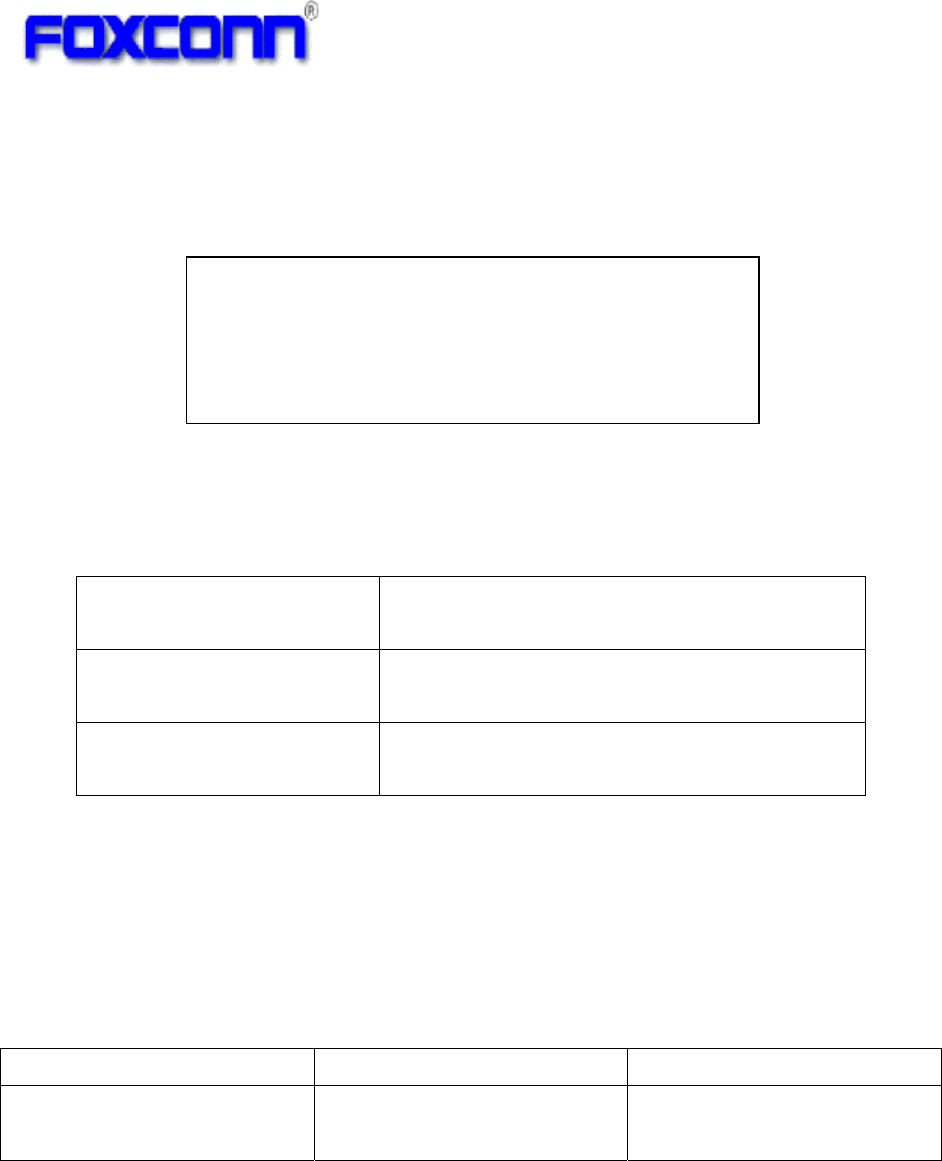
COMPANY CONFIDENTIAL
Part Name Bluetooth Module
Doc. Rev. 0.0
Foxconn P/N. J20H077.00
Prepared by Reviewed by Approved by
Kevin Tao Eddie Huang
User Manual
Bluetooth Module

COMPANY CONFIDENTIAL
Content
Section1 Introduction ..............................................................................................................3
1. Product Overview ................................................................................................................3
1.1 Application scope..................................................................................................... 3
1.2 Block Diagram.......................................................................................................... 3
1.3 Features .................................................................................................................... 4
1.4 Interface and Connector......................................................................................... 4
2. Electrical Specification ........................................................................................................5
2.1 Recommended operating rating............................................................................ 5
2.2 DC Characteristics .................................................................................................. 5
2.3 ESD Information ...................................................................................................... 5
2.4 Environment Storage Condition ............................................................................ 5
3. RF Specification ...................................................................................................................6
3.1 Bluetooth 3.0 ............................................................................................................ 6
3.2 Antenna Characteristic............................................................................................ 7
4. Mechanical Specifications ...................................................................................................8
4.1 PCB Assembly Dimension ..................................................................................... 8
Section2 WinXP utility and install .........................................................................................9
5. Overview ...............................................................................................................................9
6. Requirements........................................................................................................................9
7. USB to UART Interface Driver Install ..............................................................................9
8. Test Tool Install .................................................................................................................11
8.1 ActivePerl-5[1].8.4.810-MSWin32-x86.msi install............................................. 11
8.2 dotnetfx.exe install................................................................................................. 12
8.3 setup_for 20702A1.exe ........................................................................................ 12
9. Blue Tool Test Setting ........................................................................................................14
9.1 Tx Mode .................................................................................................................. 14
9.2 Rx Mode.................................................................................................................. 19

COMPANY CONFIDENTIAL
Section1 Introduction
1. Product Overview
The J20H077.00 Bluetooth module provides Bluetooth 3.0 compliant wireless modem
function. This module is based on BCM20705 solution which is integrated 2.4GHz
transceiver and manufactured using the industry’s most advanced 65nm CMOS
low-power process.
1.1 Application scope
The BT Module is compliant to Bluetooth 3.0 and EDR standard:
Carrier Frequency: 2402MHz ~ 2480 MHz
Carrier Spacing: 1.0MHz
Duplexing: TDD
Modulation: FHSS
GFSK, pi/4-DQPSK, 8DPSK
Symbol Rate: 1Mbps (GFSK), 2Mbps (pi/4-DQPSK), 3Mbps (8DPSK)
This module is designed with BTB connector and UART Interface, and it is
installed as a client device in TV platform.
1.2 Block Diagram
The general HW architecture is shown below Figure:
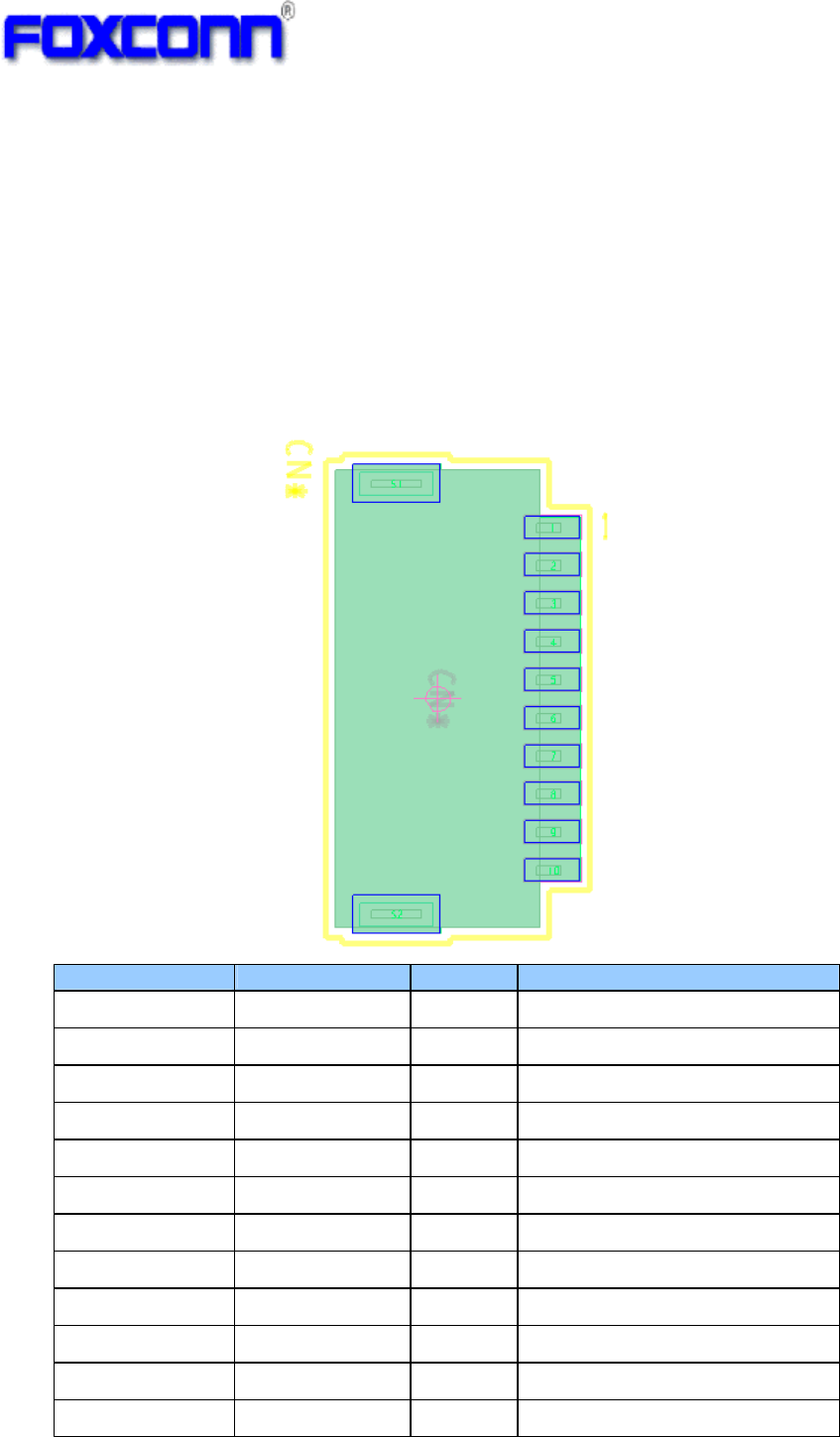
COMPANY CONFIDENTIAL
1.3 Features
i Bluetooth 3.0 Compliant
i UART Interface.
i Module is powered by the host with a 3.3V +/- 10% supply.
i One PCB printed antenna.
i 4 layers through hole PCB design with halogen free FR4 material
1.4 Interface and Connector
iPin definition:
Pin Number Symbol Name Status Pin definition
1GND P Ground
2UARTTXD O UART Transimit
3UARTRXD I UART Receive
4GND P Ground
5BT_RST I BT Reset
6BT_DEVICE_WAKE I BT wake up Signal
7BT_HOST_WAKE O Host wake up Signal
8EMT_SYNC I -
9GND P Ground
10 VDD_3P3 P Power
S1 GND P Ground
S2 GND P Ground
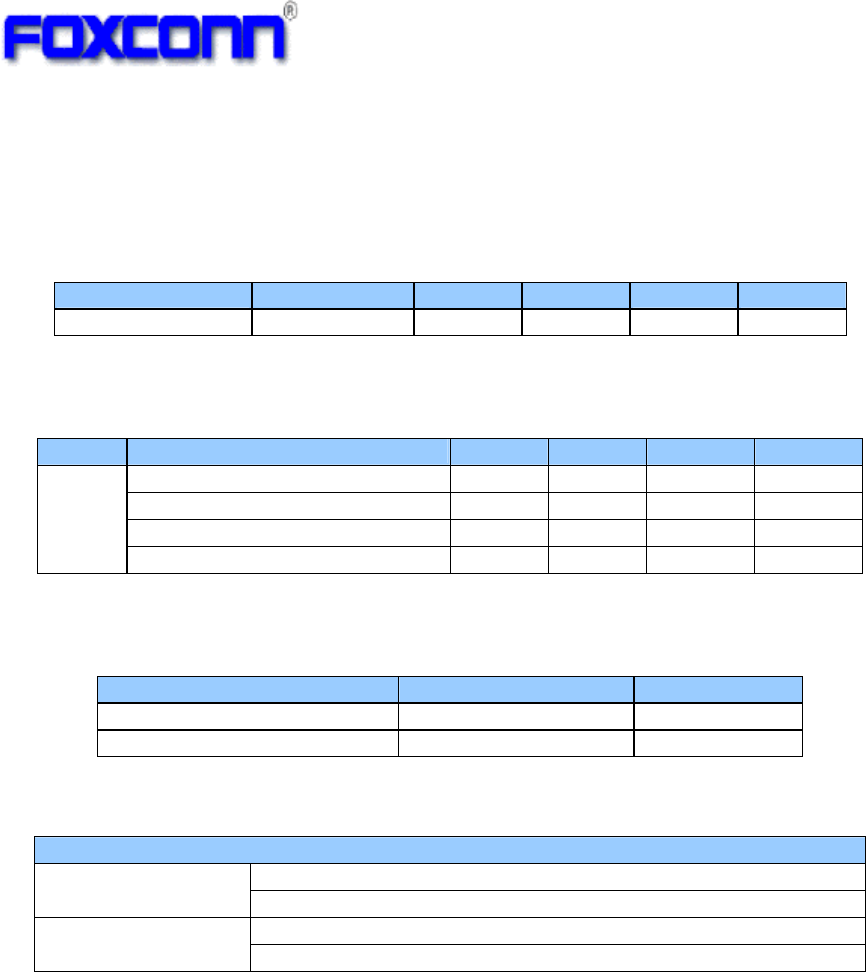
COMPANY CONFIDENTIAL
2. Electrical Specification
2.1 Recommended operating rating
Element Symbol Min Typ Max Unit
DC supply voltage UV+ 3.0 3.3
3.6 (V)
2.2 DC Characteristics
Symbol Parameter Min Typ Max Unit
Supply voltage 3.0 3.3 3.6 (V)
Tx Current - 40 50 (mA)
Rx Current - 26 32 (mA)
STBY3.3V
Standby Current 5 7 (mA)
2.3 ESD Information
Mode Level Unit
HBM +/-1500 V
MM +/-200 V
2.4 Environment Storage Condition
Environment condition
Operating Temperature: -10 deg.C ~70 deg.C
Temperature Storage Temperature: -40 deg.C ~80 deg.C
Operating Humidity: 5% ~95% (Non-condensing)
Humidity Storage Humidity: 5% ~95% (Non-condensing)
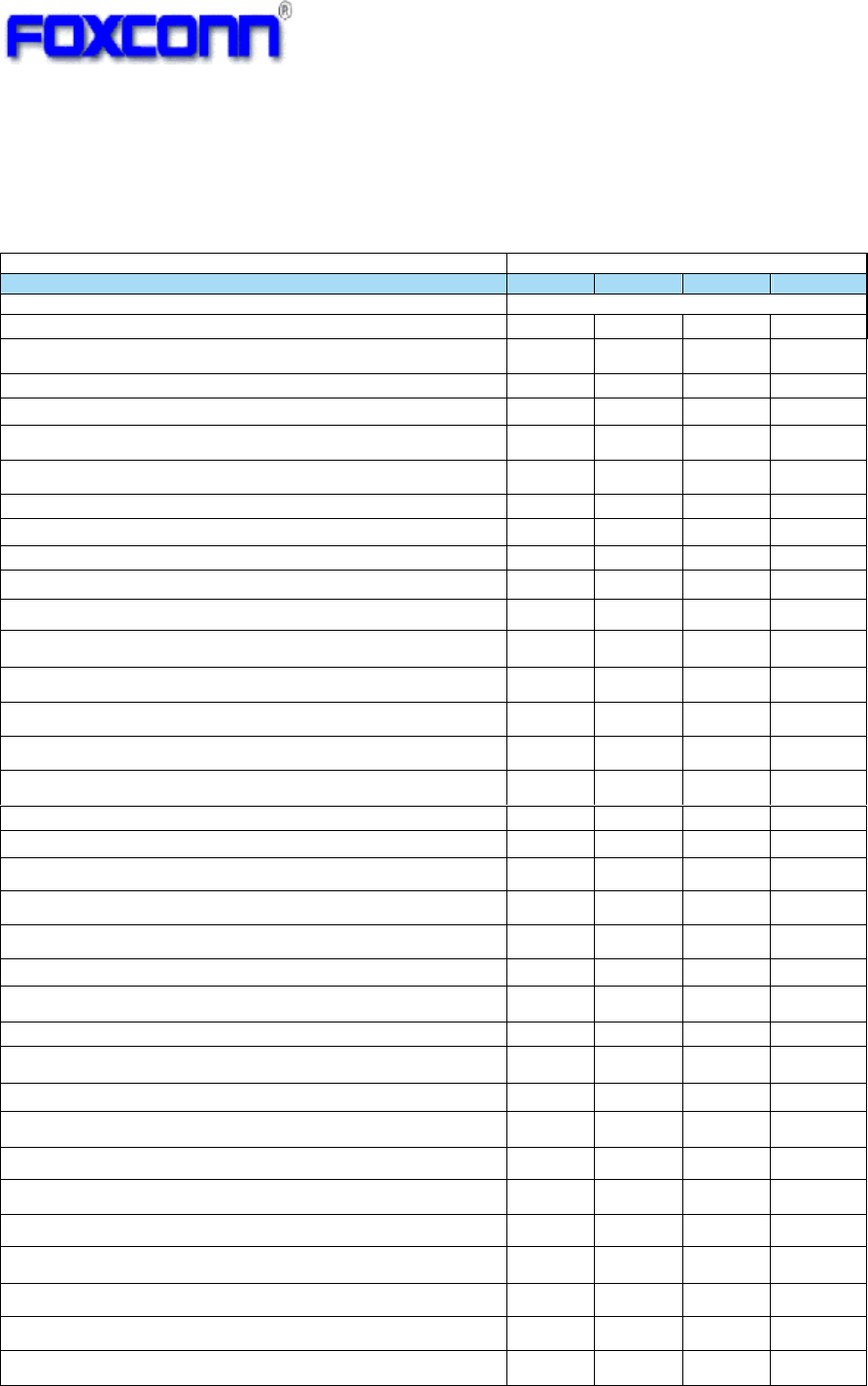
COMPANY CONFIDENTIAL
3. RF Specification
3.1 Bluetooth 3.0
Items Contents
- TX Characteristics - Min. Typ. Max. Unit
1. Power Levels ʳ
BT Output Power (Basic Data Rate) -1 1 3 dBm
2. Initial Carrier Frequency Tolerance
Average Offset -75 6 75 kHz
3. Carrier Drift
Drift Rate
DH1 -20 -4 20 kHz/50us
DH3 -20 -4 20 kHz/50us
DH5 -20 -5 20 kHz/50us
Average Drift
DH1 -25 -1 25 kHz
DH3 -40 0 40
kHz
DH5 -40 0 40
kHz
4. Modulation Characteristic
F1avg 140 150 175 kHz
F2max 115 140 kHz
F1/F2 Ratio 0.8 0.96
5. EDR Relative Transmit Power
2Mbps: P[DQPSK]-P[GFSK] -4 0.25 1 dB
3Mbps: P[8DPSK]-P[GFSK] -4 0.25 1 dB
6. EDR Carrier Frequency Stability and Modulation Accuracy
2Mbps:
±
/4 DQPSK
Initial Frequency Error: i-75 -3 75 kHz
Frequency Error: 0-10 -2 10 kHz
Block Frequency Error: i + 0-75 -5 75 kHz
RMS DEVM - 0.05 0.2
Peak DEVM - 0.12 0.35
99% DEVM (% Symbols <=0.3) 99% 100%
3Mbps:
8DPSK
Initial Frequency Error: i-75 -9 75 kHz
Frequency Error: 0-10 -1.5 10 kHz
Block Frequency Error: i + 0-75 -10 75
kHz
RMS DEVM - 0.05 0.13
Peak DEVM - 0.13 0.25
99% DEVM (% Symbols <=0.13) 99% 100%
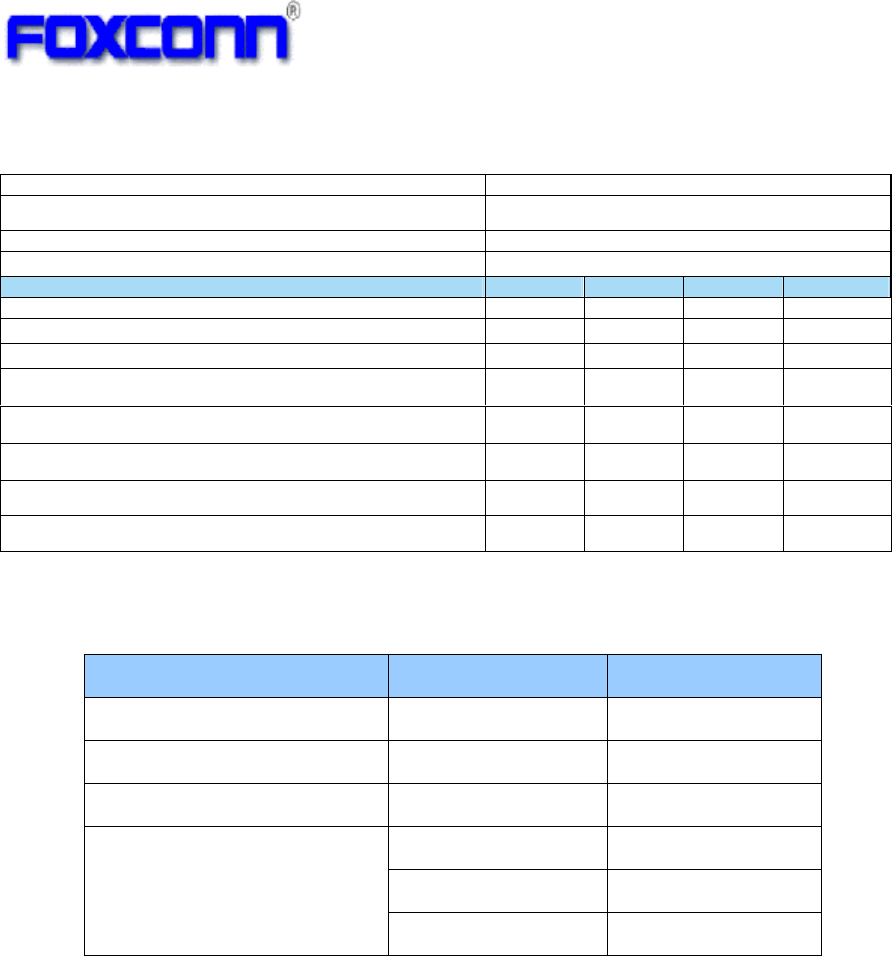
COMPANY CONFIDENTIAL
3.2 Antenna Characteristic
Parameter Value Units
Operating frequency range 2402~2483.5 MHz
Antenna gain (max) 0.13 dBi
VSWR <2.1 /
43% @2402MHz /
44% @2441MHz /
Efficiency
40% @2480MHz /
Items Contents
Specification BT3.0
Frequency range 2.4GHz~2.4835GHz
Data rate 1Mbps, 2Mbps, 3Mbps
- RX Characteristics - Min. Typ. Max. Unit
1. Minimum Input Level Sensitivity ʳʳʳ ʳ
GFSK (1Mbps) - -90 -83 dBm
±/4 DQPSK (2Mbps) - -90 -83 dBm
8DPSK (3Mbps) - -85 -77 dBm
2. Maximum Input Level ʳʳʳ ʳ
GFSK (1Mbps) -20 0 dBm
±/4 DQPSK (2Mbps) -20 -14 dBm
8DPSK (3Mbps) -20 -14 dBm
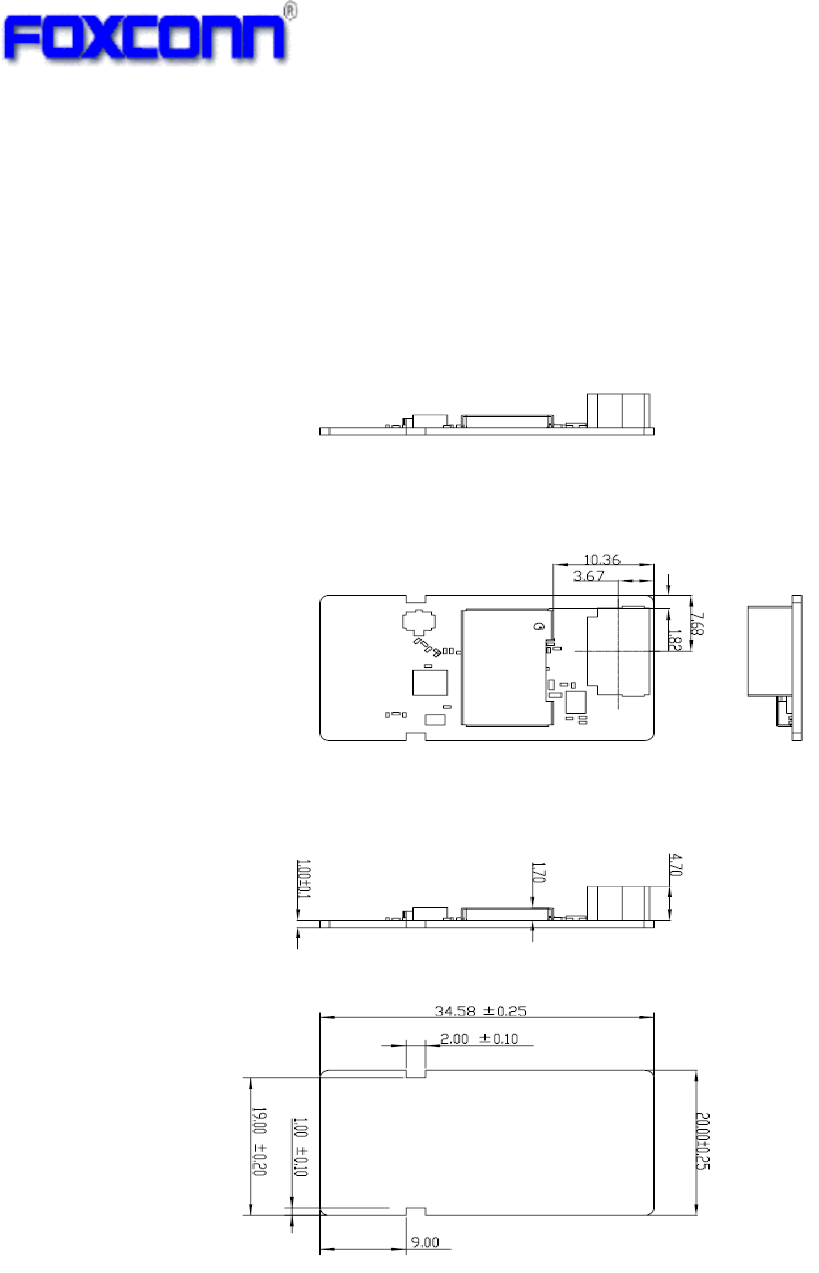
COMPANY CONFIDENTIAL
4. Mechanical Specifications
4.1 PCB Assembly Dimension
Dimension (W x L ): 34.58mmx20mm PCB: 4 layer HF-FR4
design
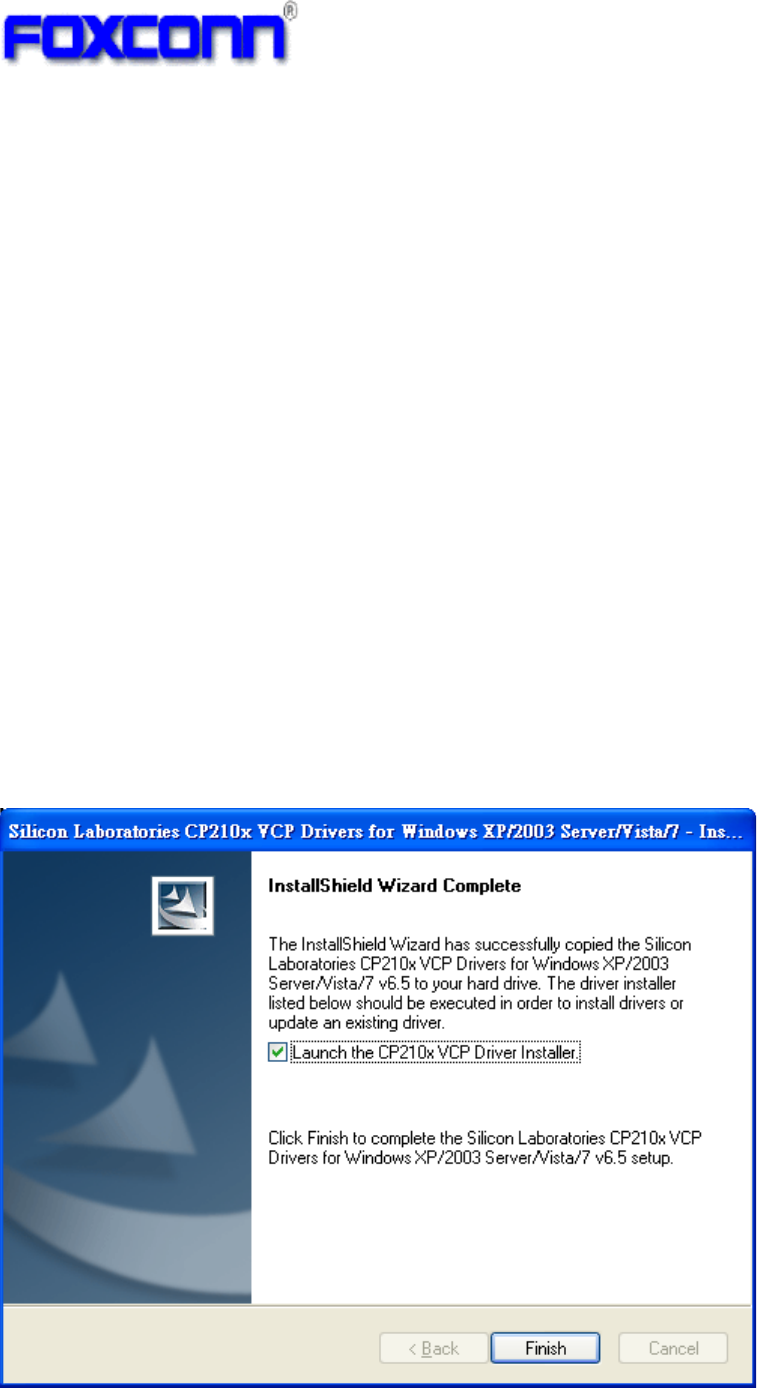
COMPANY CONFIDENTIAL
Section2 WinXP utility and install
5. Overview
This document is intended to provide a brief introduction to the Mckinley test for users.
It includes the initial setup instruction on how to configure the device and test the
transmitter.
6. Requirements
Hardware
- Desktop PC with USB interface
Software
- Windows XP Professional (SP3 or above)
- USB to UART DRIVER
- Bluetooth Test Tool
7. USB to UART Interface Driver Install
Step1: Go to “* \BT\Test Tool\uart driver\V6.5” and double click
“CP210x_VCP_Win_XP_S2K3_Vista_7.exe” to install USB to UART Interface driver.
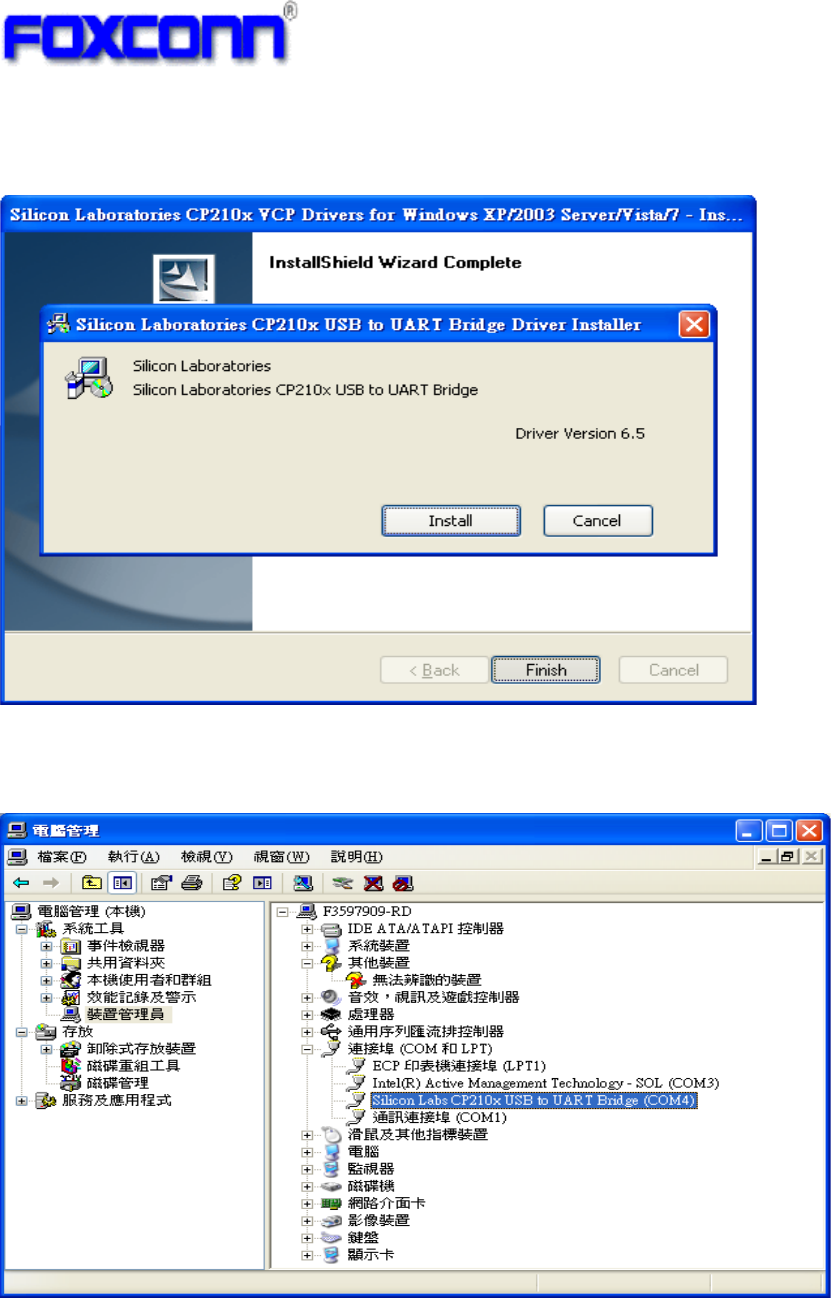
COMPANY CONFIDENTIAL
Step2: Select “Launch the CP210x VCP Driver Installer”, and click the “Finish” button
to start the install.
Step3: Finish installation and Insert the Conversion Board with Module, you will get a
card named”Silicon Labs CP210x USB to UART Bridge” in computer management..
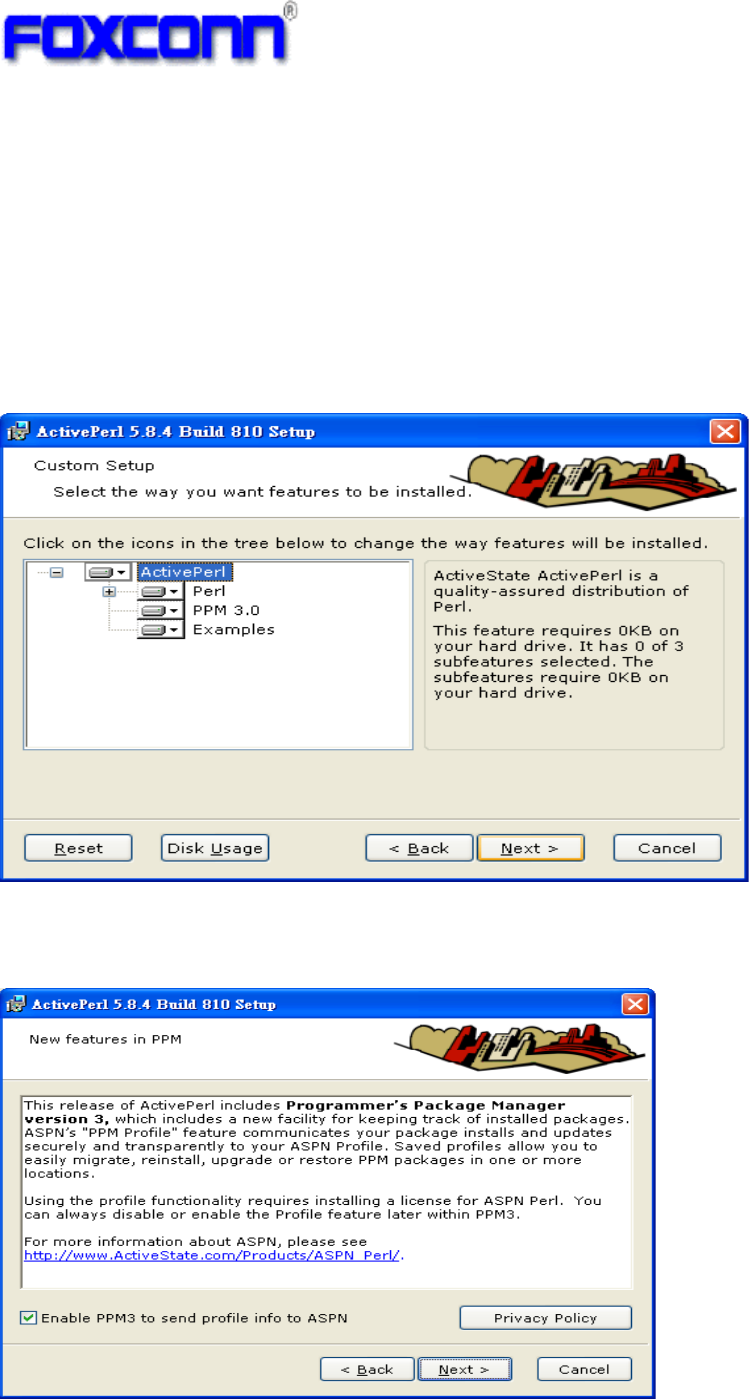
COMPANY CONFIDENTIAL
8. Test Tool Install
8.1 ActivePerl-5[1].8.4.810-MSWin32-x86.msi install
Step1: Go to “* \BT\Test Tool” and double click
“ActivePerl-5[1].8.4.810-MSWin32-x86.msi” to install
Step2: Select the default setting, and then click the “Next>” button to show the next
page.
Step3: Select ”Enable PPM3 to send profile info to ASPN ”, and then click the “Next>”
button to show the next page.
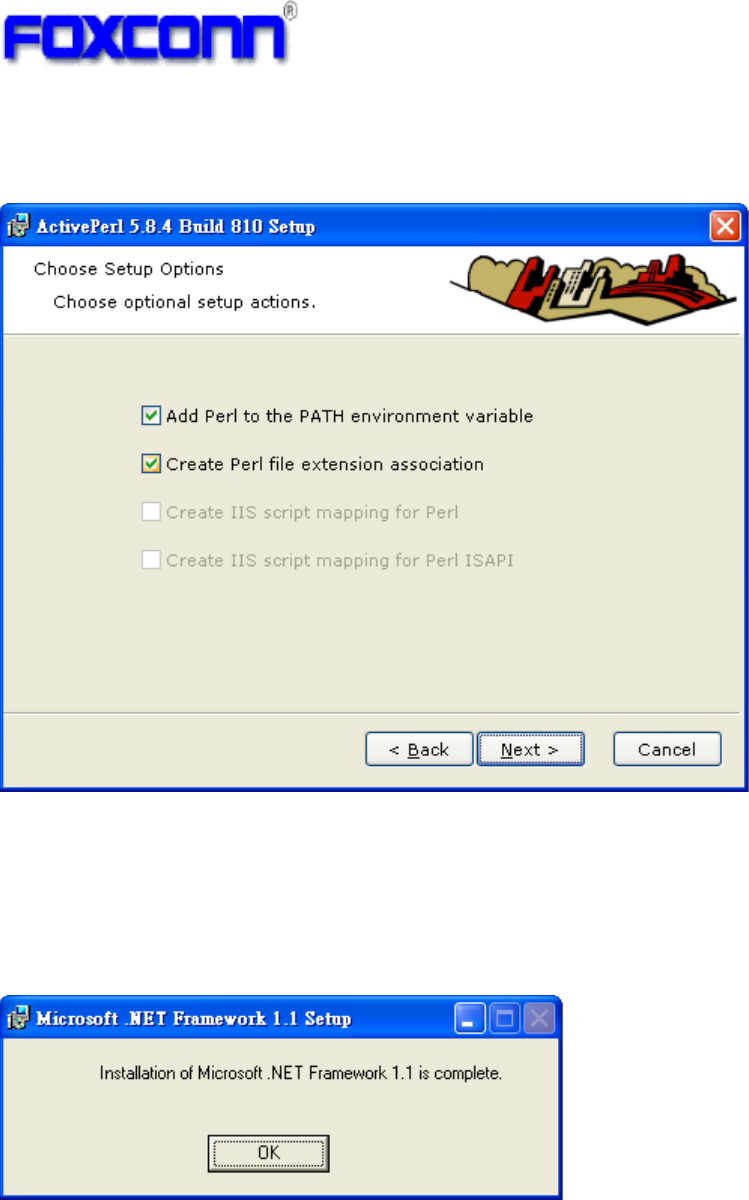
COMPANY CONFIDENTIAL
Step4: Select the default setting, and then click the “Next>” button to continue the
installation.
8.2 dotnetfx.exe install
Step1: Go to “* \BT\Test Tool” and double click “dotnetfx.exe” to install Microsoft.net
Framework 1.1
8.3 setup_for 20702A1.exe
Step1: Go to “* \BT\Test Tool” and double click “setup_for 20702A1.exe” to install
BlueTool
Step2: Select the “Typical”, and then click the “Next>” button to continue the
installation.
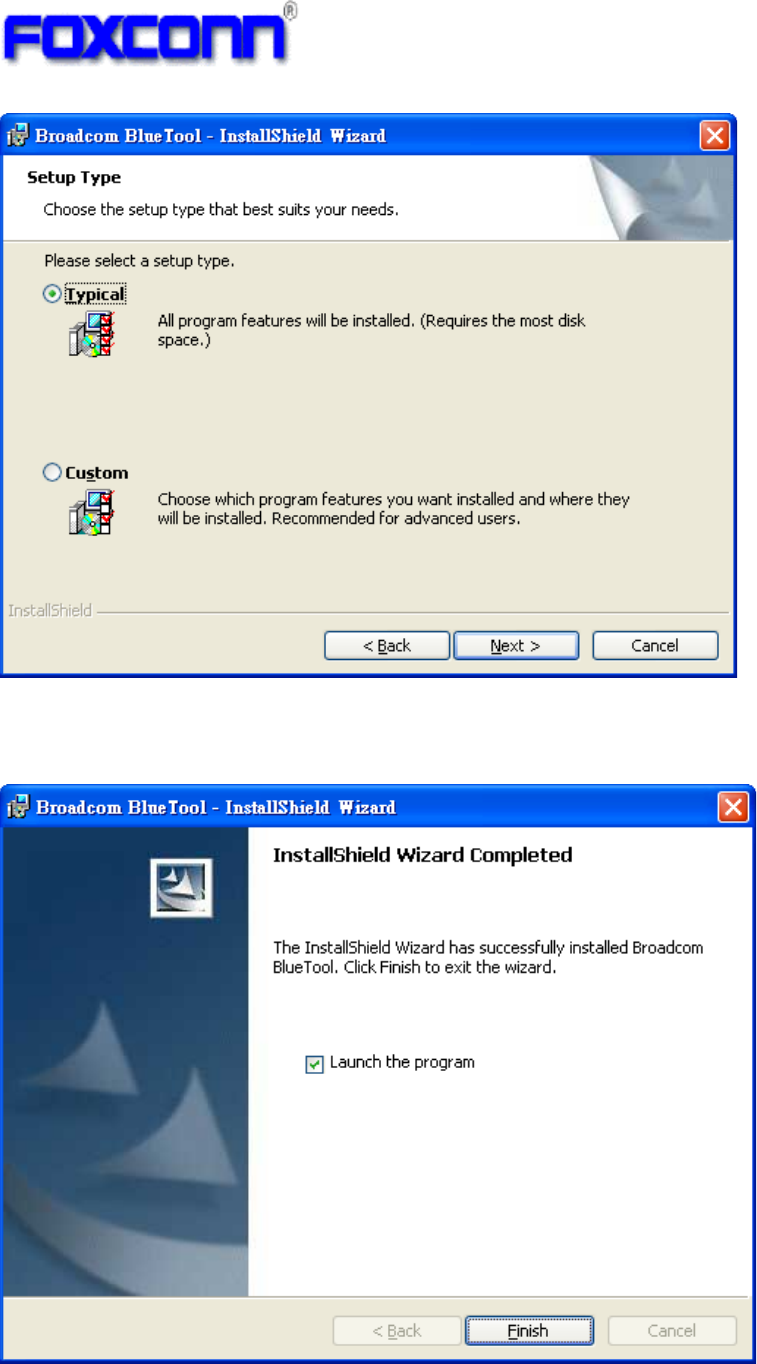
COMPANY CONFIDENTIAL
Step3: Click the “Finish” button to finish the installation.
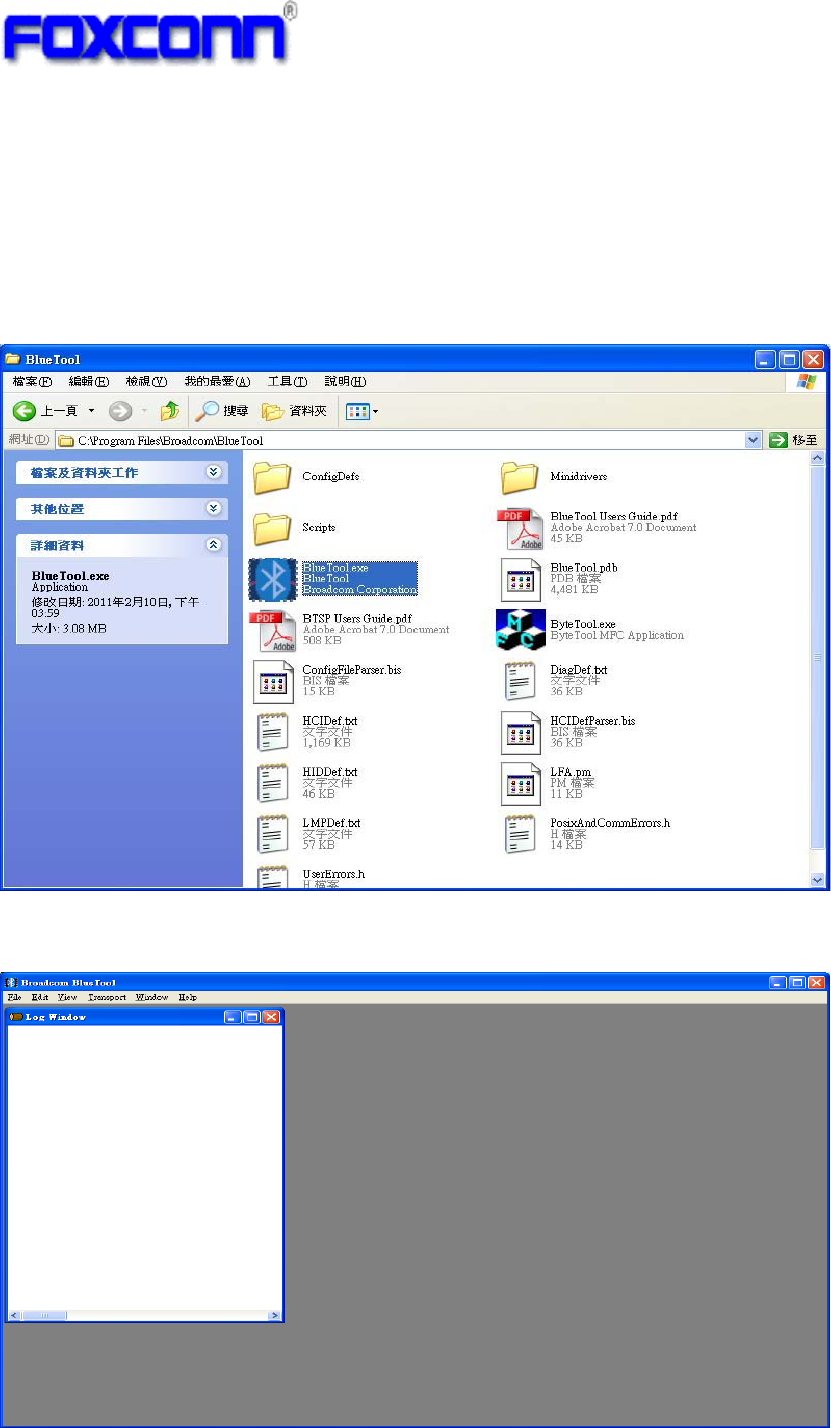
COMPANY CONFIDENTIAL
9. Blue Tool Test Setting
9.1 Tx Mode
Step1: Go to “C:\Program Files\Broadcom\BlueTool “to double click the
“BlueTool.exe” to run Blue Tool
Step2: Select “View ->Log Window “to show the log window
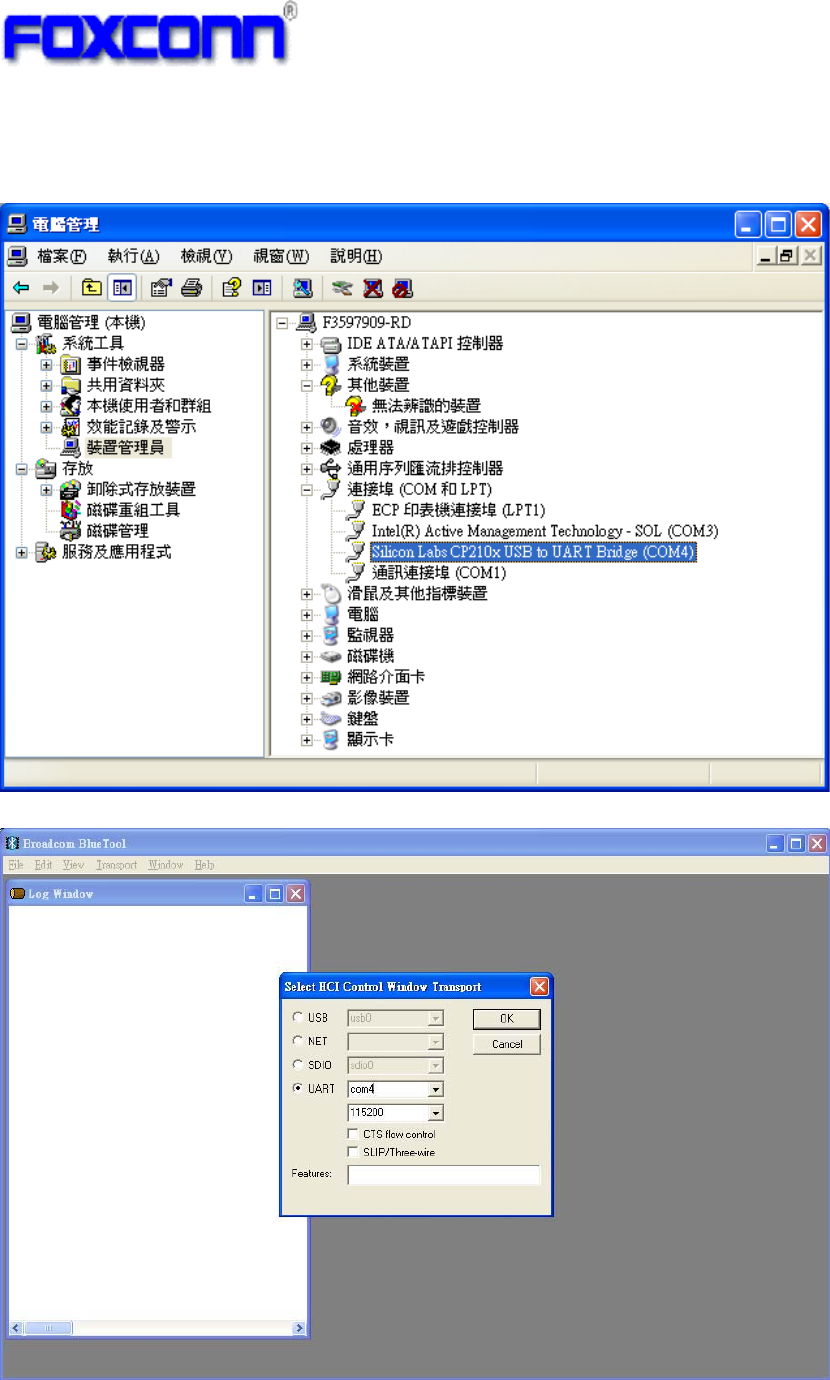
COMPANY CONFIDENTIAL
Step3: Select “Transport ->HCI Control.. “to select the interface based on the
computer management.
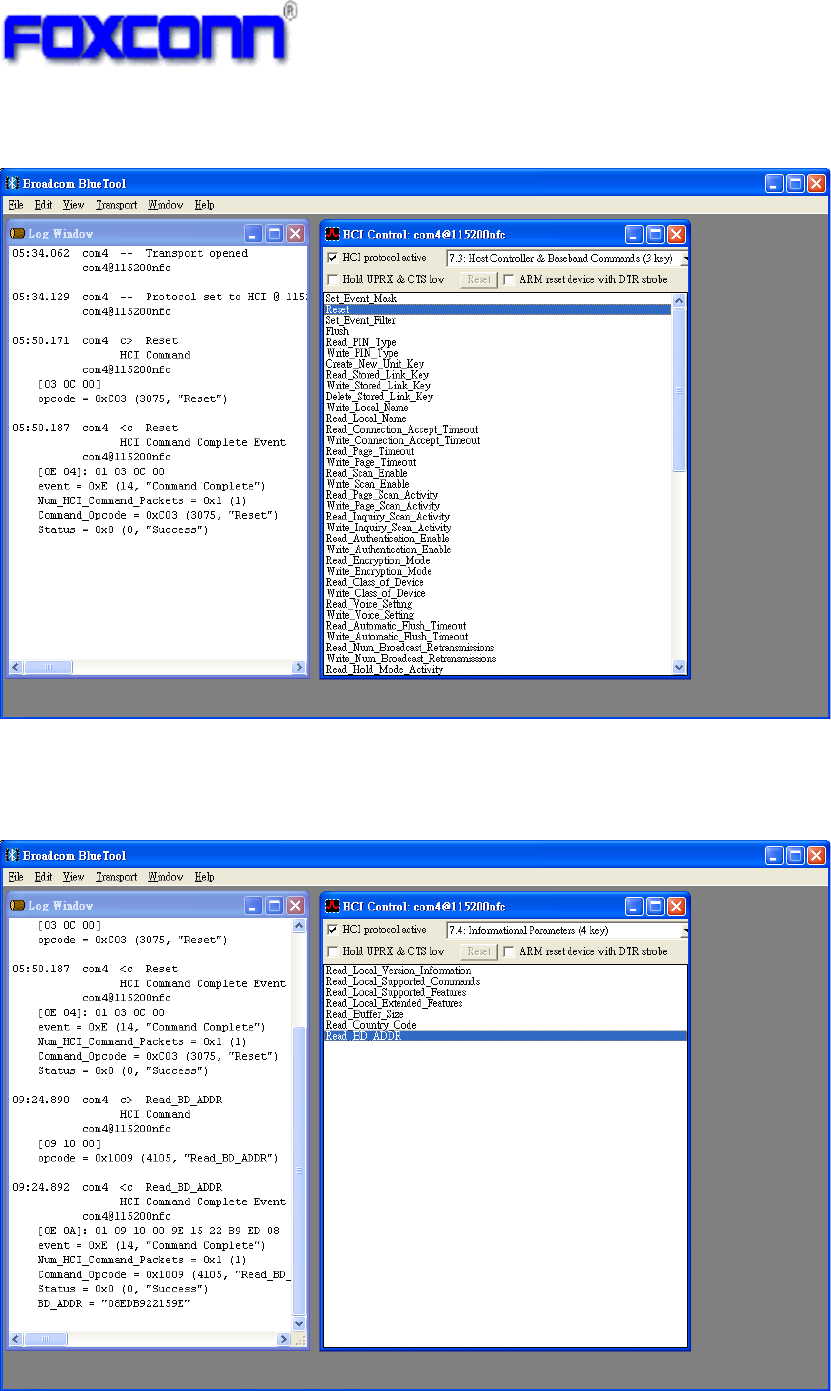
COMPANY CONFIDENTIAL
Step4: Select “7.3: Host controller & Baseband Commands(3 Key) “ and do “Reset” .
Step5: Select “7.4: Informational Parameters(4 Key) “ and do “Read_BD_ADDR” to
read the MAC ID
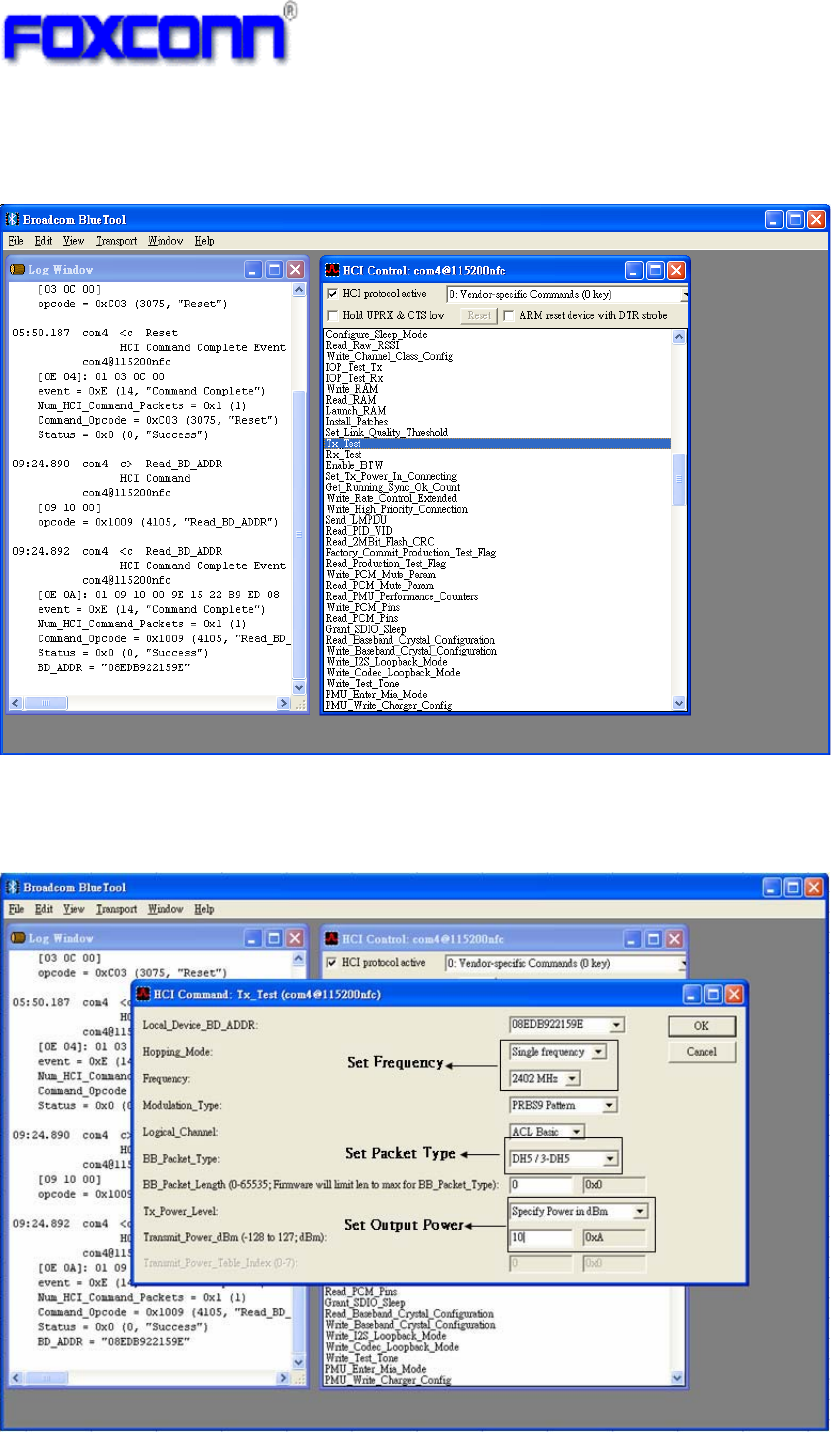
COMPANY CONFIDENTIAL
Step6: Select “0: Verdor-specific Commands(0 Key) “ and do “Tx Test” to set Tx
Mode
Step7: Select “0: Verdor-specific Commands(0 Key) “ and do “Tx Test” to set Tx
Mode, set packet type DH5,output power 10dBm , then click “OK”
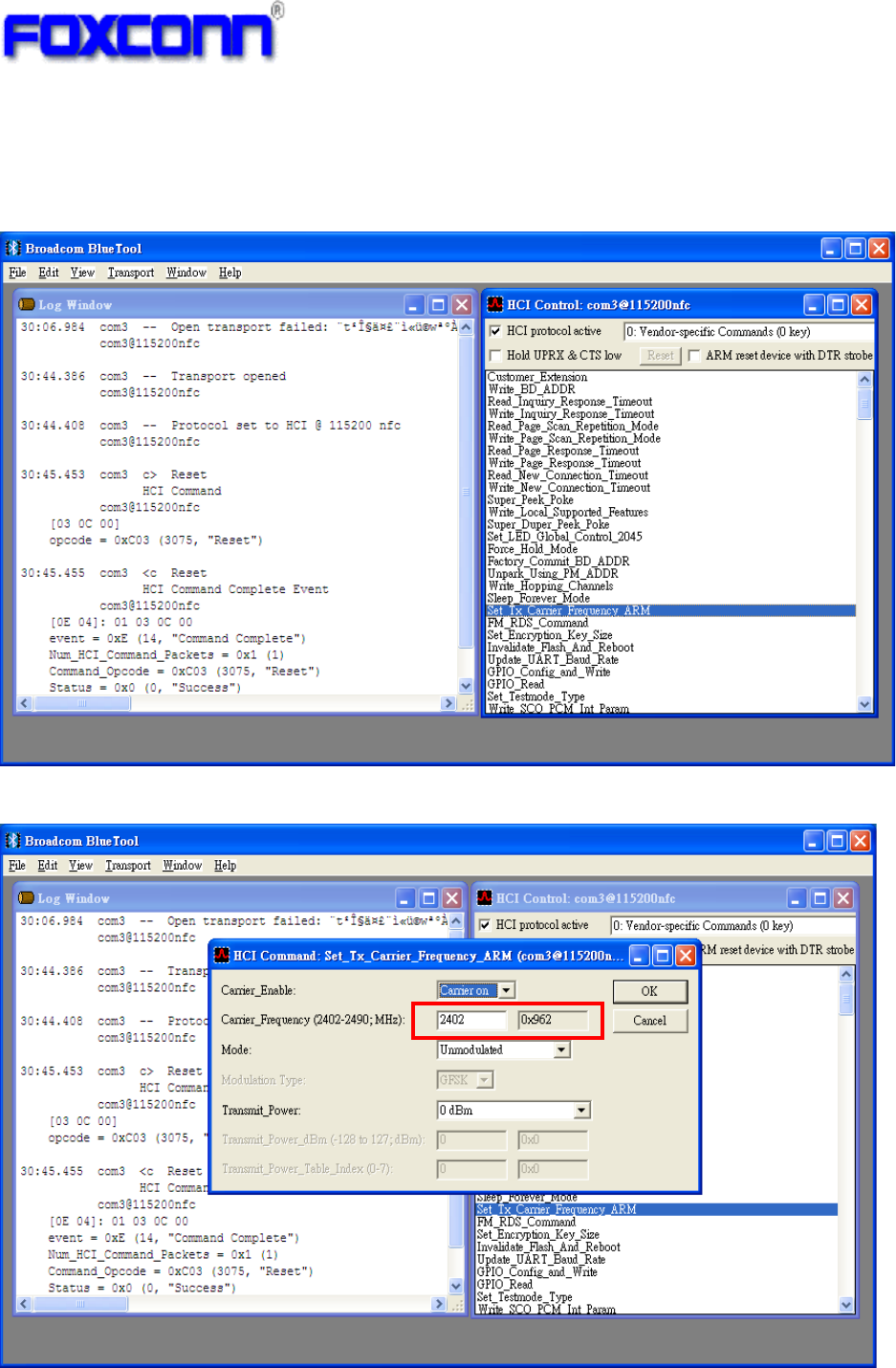
COMPANY CONFIDENTIAL
9.2 Frequency Deviation Test
Step1: Based on Section 9.1 Step5 , Select “0: Verdor-specific Commands(0 Key)
and do “Set Tx Carrier Frequency ARM” to set Frequency Deviation Test .
Step2: Select frequency for Frequency Deviation Test .
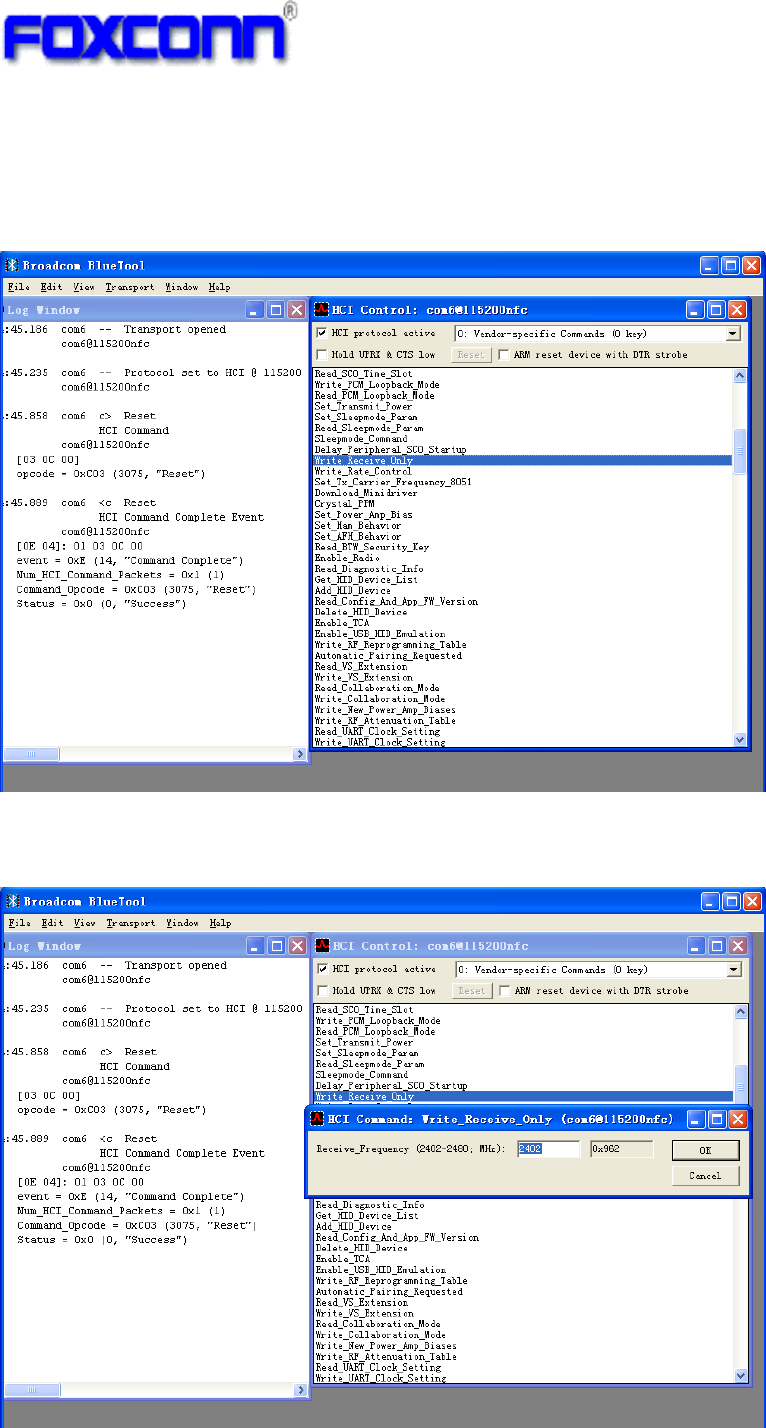
COMPANY CONFIDENTIAL
9.3 Rx Mode
Step1: Based on Section 4.1 Step5 , Select “0: Verdor-specific Commands(0 Key)
“ and do “write receive only” to set Rx Mode .
Step2: Set frequency , then click “OK”
Federal Communication Commission Interference Statement
This device complies with Part 15 of the FCC Rules. Operation is subject to
the following two conditions: (1) This device may not cause harmful
interference, and (2) this device must accept any interference received,
including interference that may cause undesired operation.
This equipment has been tested and found to comply with the limits for a
Class B digital device, pursuant to Part 15 of the FCC Rules. These limits
are designed to provide reasonable protection against harmful interference in a
residential installation. This equipment generates, uses and can radiate radio
frequency energy and, if not installed and used in accordance with the
instructions, may cause harmful interference to radio communications.
However, there is no guarantee that interference will not occur in a particular
installation. If this equipment does cause harmful interference to radio or
television reception, which can be determined by turning the equipment off
and on, the user is encouraged to try to correct the interference by one of the
following measures:
- Reorient or relocate the receiving antenna.
- Increase the separation between the equipment and receiver.
- Connect the equipment into an outlet on a circuit different from that
to which the receiver is connected.
- Consult the dealer or an experienced radio/TV technician for help.
FCC Caution: Any changes or modifications not expressly approved by the
party responsible for compliance could void the user's authority to operate this
equipment.
This transmitter must not be co-located or operating in conjunction with any
other antenna or transmitter.
Radiation Exposure Statement:
The product comply with the FCC portable RF exposure limit set forth for an
uncontrolled environment and are safe for intended operation as described in
this manual. The further RF exposure reduction can be achieved if the product
can be kept as far as possible from the user body or set the device to lower
output power if such function is available.

This device is intended only for OEM integrators under the following
conditions:
The transmitter module may not be co-located with any other transmitter or
antenna.
As long as the conditions above are met, further transmitter test will not be
required. However, the OEM integrator is still responsible for testing their
end-product for any additional compliance requirements required with this
module installed
IMPORTANT NOTE: In the event that these conditions can not be met (for
example certain laptop configurations or co-location with another transmitter),
then the FCC authorization is no longer considered valid and the FCC ID can
not be used on the final product. In these circumstances, the OEM integrator will
be responsible for re-evaluating the end product (including the transmitter) and
obtaining a separate FCC authorization.
End Product Labeling
The final end product must be labeled in a visible area with the following:
“Contains FCC ID:MCLJ20H077”. The grantee's FCC ID can be used only when
all FCC compliance requirements are met.
Manual Information To the End User
The OEM integrator has to be aware not to provide information to the end user
regarding how to install or remove this RF module in the user’s manual of the
end product which integrates this module.
The end user manual shall include all required regulatory information/warning as
show in this manual.
Industry Canada statement:
This device complies with RSS-210 of the Industry Canada Rules. Operation is
subject to the following two conditions: (1) This device may not cause harmful
interference, and (2) this device must accept any interference received, including
interference that may cause undesired operation.
Ce dispositif est conforme à la norme CNR-210 d'Industrie Canada applicable aux
appareils radio exempts de licence. Son fonctionnement est sujet aux deux conditions
suivantes: (1) le dispositif ne doit pas produire de brouillage préjudiciable, et (2) ce
dispositif doit accepter tout brouillage reçu, y compris un brouillage susceptible de
provoquer un fonctionnement indésirable.
Radiation Exposure Statement:
The product comply with the Canada portable RF exposure limit set forth for an
uncontrolled environment and are safe for intended operation as described in this
manual. The further RF exposure reduction can be achieved if the product can be kept
as far as possible from the user body or set the device to lower output power if such
function is available.
Déclaration d'exposition aux radiations:
Le produit est conforme aux limites d'exposition pour les appareils portables RF pour
les Etats-Unis et le Canada établies pour un environnement non contrôlé.
Le produit est sûr pour un fonctionnement tel que décrit dans ce manuel. La réduction
aux expositions RF peut être augmentée si l'appareil peut être conservé aussi loin que
possible du corps de l'utilisateur ou que le dispositif est réglé sur la puissance de sortie
la plus faible si une telle fonction est disponible.
This device is intended only for OEM integrators under the following conditions: (For
module device use)㩷
The transmitter module may not be co-located with any other transmitter or antenna.
As long as the conditions above are met, further transmitter test will not be required.
However, the OEM integrator is still responsible for testing their end-product for any
additional compliance requirements required with this module installed.
Cet appareil est conçu uniquement pour les intégrateurs OEM dans les conditions
suivantes: (Pour utilisation de dispositif module)
Le module émetteur peut ne pas être coïmplanté avec un autre émetteur ou antenne.㩷
Tant que les le conditions ci-dessus sont remplies, des essais supplémentaires sur
l'émetteur ne seront pas nécessaires. Toutefois, l'intégrateur OEM est toujours
responsable des essais sur son produit final pour toutes exigences de conformité
supplémentaires requis pour ce module installé.
IMPORTANT NOTE:
In the event that these conditions can not be met (for example certain laptop
configurations or co-location with another transmitter), then the Canada authorization
is no longer considered valid and the IC ID can not be used on the final product. In
these circumstances, the OEM integrator will be responsible for re-evaluating the end
product (including the transmitter) and obtaining a separate Canada authorization.
NOTE IMPORTANTE:㩷
Dans le cas où ces conditions ne peuvent être satisfaites (par exemple pour certaines
configurations d'ordinateur portable ou de certaines co-localisation avec un autre
émetteur), l'autorisation du Canada n'est plus considéré comme valide et l'ID IC ne
peut pas être utilisé sur le produit final. Dans ces circonstances, l'intégrateur OEM
sera chargé de réévaluer le produit final (y compris l'émetteur) et l'obtention d'une
autorisation distincte au Canada.
End Product Labeling
The final end product must be labeled in a visible area with the following: “Contains
IC: 2878D-J20H077”.
Plaque signalétique du produit final
Le produit final doit être étiqueté dans un endroit visible avec l'inscription suivante:
"Contient des IC: 2878D-J20H077".
Manual Information To the End User
The OEM integrator has to be aware not to provide information to the end user
regarding how to install or remove this RF module in the user’s manual of the end
product which integrates this module.
The end user manual shall include all required regulatory information/warning as
show in this manual.

Manuel d'information à l'utilisateur final
L'intégrateur OEM doit être conscient de ne pas fournir des informations à l'utilisateur
final quant à la façon d'installer ou de supprimer ce module RF dans le manuel de
l'utilisateur du produit final qui intègre ce module.
Le manuel de l'utilisateur final doit inclure toutes les informations réglementaires
requises et avertissements comme indiquͼ dans ce manuel.
For Taiwan ᤞΚ
ᆖীڤᎁᢞٽհ܅פ୴᙮ሽᖲΔॺᆖױΔֆΕᇆࢨࠌشृ݁լᖐ۞᧢ޓ᙮
ΕףՕפࢨ᧢ޓૠհࢤ֗פ౨Ζ
܅פ୴᙮ሽᖲհࠌشլᐙଆڜ٤֗եឫٽऄຏॾΙᆖ࿇ڶեឫွழΔᚨم
ܛೖشΔࠀޏ۟ྤեឫழֱᤉᥛࠌشΖছႈٽऄຏॾΔਐࠉሽॾऄࡳ܂ᄐհྤᒵ
ሽຏॾΖ܅פ୴᙮ሽᖲႊݴ࠹ٽऄຏॾࢨՠᄐΕઝᖂ֗᠔᛭شሽंᘿ୴ࢤሽᖲໂհ
եឫΖ
Note: 1. ءᑓิ࣍࠷ᎁᢞ৵ലࠉࡳ࣍ᑓิء᧯ᑑقᐉ᧭ٽᑑ᧘ 2. ߓอᐗᚨ
࣍ؓՂᑑقψءขփܶ୴᙮ᑓิ: XXXyyyLPDzzzz-x (NCC ID) ωڗᑌ.